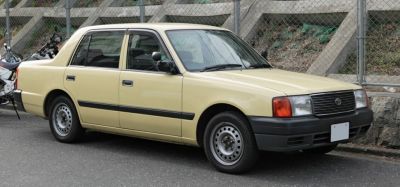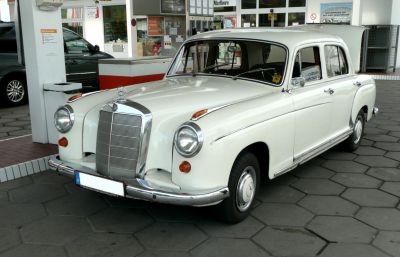 1956 Mercedes-Benz W180 II Sedan Dimensions, Size & Specs
1956 Mercedes-Benz W180 II Sedan Dimensions, Size & SpecsMeasurements of the 1956 Mercedes-Benz W180 II Sedan, engineered for optimal performance and comfort
| Dimensions | |
|---|---|
| Length: | 4715-4750 mm185.6-187.0 in15.5-15.6 ft |
| Width: | 1740 mm68.5 in5.7 ft |
| Height: | 1560 mm61.4 in5.1 ft |
| Weight Specifications | |
| Curb Weight: | 1325-1340 kg2921-2954 lbs |
| Maximal permitted Weight: | 1790 kg3946 lbs |
The Mercedes-Benz Ponton W180 II Sedan, produced from 1956 to 1959, is a classic luxury sedan that reflects mid-20th century automotive design and engineering excellence. This second generation W180 model improved on its predecessor with refined styling and enhanced mechanical sophistication, making it a cherished vehicle among classic car enthusiasts.
Dimension-wise, the Mercedes-Benz Ponton W180 II Sedan ranges from approximately 4715 mm to 4750 mm in length (185.6 to 187 inches), with a consistent width of 1740 mm (68.5 inches) and a height of 1560 mm (61.4 inches). These compact dimensions for a luxury sedan of its era contributed to its agile handling and graceful presence on the road. Weighing between 1325 kg and 1340 kg (2921 to 2954 lbs) in curb weight and capable of carrying up to a maximum weight of 1790 kg (3946 lbs), the Ponton balanced solid build quality with efficient performance.
The W180 II Sedan was designed with comfortable seating for up to five passengers, embodying Mercedes-Benz's signature craftsmanship and attention to detail. Its elegant proportions and trim fitting perfectly with mid-1950s styling cues, featuring smooth curves and restrained chrome accents.
Overall, the Mercedes-Benz Ponton W180 II Sedan remains a symbol of post-war luxury and reliability, with its dimensions and weight contributing both to its road presence and driving experience. When comparing classic sedans, the W180 II stands out for its ideal size balance, making it a timeless collector's car with enduring automotive appeal.
Discover the standout features that make the 1956 Mercedes-Benz W180 II Sedan a leader in its class
Have a question? Please check our knowledgebase first.
The Mercedes-Benz Ponton W180 II Sedan produced between 1956 and 1959 features a length ranging from 4715 to 4750 millimeters (185.6 to 187 inches), a width of 1740 millimeters (68.5 inches), and a height of 1560 millimeters (61.4 inches). These dimensions reflect the car's classic mid-century design, offering a balanced size that combines interior comfort with manageable exterior proportions typical for sedans of that era.
This generation of the Mercedes-Benz Ponton W180 sedan has a curb weight between 1325 and 1340 kilograms (2921 to 2954 pounds). Its maximum permissible weight, including passengers and cargo, is 1790 kilograms (3946 pounds). These weight specifications ensure the vehicle maintains robust structural integrity while delivering a smooth and stable driving experience.
The W180 II Sedan's moderate dimensions allow it to fit comfortably in a standard residential garage, which typically measures about 2.4 to 3 meters (7.9 to 9.8 feet) in width and around 5.5 to 6 meters (18 to 20 feet) in length. With the vehicle's width at 1740 mm (68.5 inches) and length up to 4750 mm (187 inches), the car can be accommodated in most standard garages, though careful maneuvering is advisable given the relatively tight clearances.
The W180 II Ponton is slightly larger than its predecessor, offering enhanced interior space and a more refined exterior presence. The increase in length to up to 4750 mm (187 inches) and slight adjustments in width and height allowed for better passenger comfort and improved road presence. This evolution reflected Mercedes-Benz's response to market trends favoring slightly larger and more luxurious sedans, making it a more spacious and premium offering than previous Ponton models.
When compared to contemporaries like the BMW 501 or the Jaguar Mark 1, the Mercedes-Benz Ponton W180 II stands out with its solid construction and classic elegance. Dimensionally, it is similar in length and width to these models, but tends to have a slightly more conservative width at 1740 mm (68.5 inches) compared to some wider British sedans of the time, balancing road stability with urban practicality.
While the precise interior dimensions such as legroom and headroom vary slightly, the W180 II Ponton sedan was designed to comfortably seat four to five passengers. Its exterior size and classic three-box body style allow for adequate rear legroom and headroom, particularly for its era. This makes it suitable for both city driving and longer journeys, maintaining a blend of comfort and classic compact sedan dimensions.
With a height of 1560 millimeters (61.4 inches), the W180 II Sedan maintains a relatively low center of gravity, contributing to stable handling characteristics, especially at the moderate speeds typical of cars produced in this period. Its not-too-tall stature also facilitates easier parking, making it user-friendly for urban environments and garages with limited clearance.
At a curb weight ranging from 1325 to 1340 kilograms (2921 to 2954 pounds), the W180 II is moderate in weight relative to other luxury sedans of the 1950s. This weight reflects sturdy construction with classic heavy gauge steel, contributing to a solid, safe ride but also impacting fuel efficiency compared to lighter contemporaries. The weight balances durability with performance expectations of the time.
This model's maximum permissible weight is 1790 kilograms (3946 pounds), which means it can accommodate passengers and cargo up to approximately 450 to 465 kilograms (992 to 1025 pounds) beyond its curb weight. This capacity is typical for sedans of its class and era, allowing for comfortable passenger occupancy alongside luggage or small cargo loads.
The Mercedes-Benz Ponton W180 II Sedan, produced from 1956 to 1959, represents a significant step in automotive design and engineering for Mercedes-Benz. It introduced improvements in styling and mechanical sophistication over the original Ponton series, featuring a more spacious interior and refined performance. The vehicle is recognized for its classic post-war design elegance, its sturdy build quality, and representing luxury driving of its time. It holds an important place in Mercedes-Benz history as a predecessor to more modern luxury sedans.
Discover similar sized cars.

| Production: | 1995-1999 |
|---|---|
| Model Year: | 1995 |
| Length: | 4695 mm184.8 in |
| Width: | 1695 mm66.7 in |
| Height: | 1515 mm59.6 in |

| Production: | 1958-1959 |
|---|---|
| Model Year: | 1958 |
| Length: | 4750 mm187.0 in |
| Width: | 1740 mm68.5 in |
| Height: | 1560 mm61.4 in |
